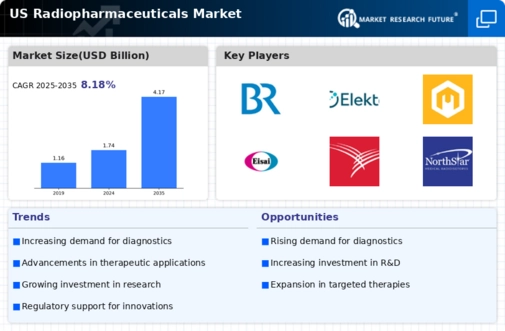Rising Awareness of Nuclear Medicine
There is growth due to the rising awareness of nuclear medicine among healthcare professionals and patients. Educational initiatives and outreach programs are effectively highlighting the benefits of radio pharmaceuticals in diagnostics and treatment. As more healthcare providers recognize the advantages of nuclear medicine, the demand for radio pharmaceuticals is expected to increase. This heightened awareness is likely to translate into greater utilization of radio pharmaceuticals in clinical practice, thereby expanding the market. Additionally, as patients become more informed about their treatment options, the acceptance of radio pharmaceuticals is anticipated to grow, further driving market expansion.
Expansion of Cancer Treatment Options
The market is poised for growth due to the expansion of cancer treatment options. With cancer rates on the rise, innovative therapies utilizing radio pharmaceuticals are becoming increasingly vital. The market for radio oncology is expected to grow at a CAGR of around 8% over the next five years, reflecting the increasing reliance on targeted therapies. Radio pharmaceuticals, such as iodine-131 and radium-223, are being integrated into treatment regimens, offering patients more effective and less invasive options. This shift towards personalized and targeted cancer therapies is likely to drive the radio pharmaceutical market, as healthcare providers seek to enhance treatment efficacy and minimize side effects.
Increasing Demand for Diagnostic Imaging
There is a notable surge in demand for diagnostic imaging procedures. This trend is largely driven by the growing prevalence of chronic diseases, which necessitate advanced imaging techniques for accurate diagnosis. According to recent data, the market for diagnostic imaging in the US is projected to reach approximately $30 billion by 2026, with radio pharmaceuticals playing a crucial role in enhancing imaging quality. The increasing adoption of PET and SPECT imaging modalities, which rely heavily on radio pharmaceuticals, further underscores this demand. As healthcare providers seek to improve patient outcomes through precise diagnostics, the radio pharmaceutical market is likely to benefit significantly from this upward trend.
Growing Investment in Research and Development
There is a surge in investment directed towards research and development (R&D). Pharmaceutical companies and research institutions are increasingly allocating resources to explore new applications and formulations of radio pharmaceuticals. This trend is indicative of a broader commitment to advancing medical science and improving patient care. In 2025, R&D spending in the pharmaceutical sector is expected to exceed $200 billion in the US, with a significant portion dedicated to radio pharmaceuticals. This influx of funding is likely to accelerate the development of innovative therapies and diagnostic tools, thereby enhancing the overall landscape of the radio pharmaceutical market.
Technological Innovations in Radio Pharmaceuticals
The market is benefiting from ongoing technological innovations that enhance the efficacy and safety of radio pharmaceuticals. Advances in radiochemistry and imaging technologies are leading to the development of new compounds with improved targeting capabilities. For instance, the introduction of novel radiotracers is enabling more precise imaging and treatment of various conditions. The market is projected to grow as these innovations facilitate the creation of more effective diagnostic and therapeutic agents. Furthermore, the integration of artificial intelligence in imaging analysis is likely to streamline workflows and improve patient outcomes, thereby bolstering the radio pharmaceutical market.






















Leave a Comment